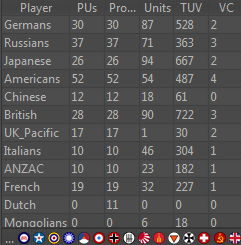Or consider it another way, just looking at the stats…
starting income (shown below as ProductionUnits) is not as helpful as a metric here, mainly because of National Objectives and the way Axis are designed to grow at the expense of Allied income. Instead take a look at the Units and the Total Unit Value (TUV) columns.
Player Nation ipc, prod, units, tuv, Victory Cities
Germans 30 30 87 528 2
Russians 37 37 71 363 3
Japanese 26 26 94 667 2
Americans 52 52 54 487 4
Chinese 12 12 18 61 0
British 28 28 90 722 3
UK_Pacific 17 17 1 30 2
Italians 10 10 46 304 1
ANZAC 10 10 23 182 1
French 19 19 32 227 1
Dutch 0 11 0 0 0
Mongolians 0 0 6 18 0
Germany= 87 units, 528 tuv
Italy= 46 units, 304 tuv
G+I = 133 units, 832 tuv
Japan= 94 units, 667 tuv
Americans + China + Russia = 143 units, 911 tuv
UK + UK Pacific + Anzac + France = 146 units, 1161 tuv
That’s already a fairly large total unit and total unit value gap to overcome, even if you split up the Americans and the British. Now imagine them taken together, and consider their position together in the turn order! And consider also that these nations each have to go through a Purchase, Combat, Non Combat, Collect income etc. If you don’t split the Anglo Americans Face to Face, not only will your Russian player get bored, but everyone will get bored watching the same dude play his turn for basically an hour while everyone else waits for their go haha :-D
I think the better question from an FtF standpoint in a Multi, is whether to split off Anzac and give them to the USA/Russia player group?
Even if that bucks with the whole UK/Commonwealth historical coordination thing. Strictly from a game flow standpoint, this provides a somewhat more balanced TUV, even if the total unit numbers seems to favor such a grouping for the Russian side, their TUV is much closer. In this case…
Russian player group with Anzac at tuv 1093.
UK group with France at tuv 979.
Basically both allied player/nations groups then have a Capital defense to consider (with brinksmanship), and an Ocean defense (with a naval cat and mouse) that are roughly on par with each other, in terms of what the player gets to do. And roughly the same in terms of their power projection.
A still better question to consider at that point, is whether to break off China from the USA/Russia group, and give it to UK instead? This would yield
Russia/USA/Anzac =1032
China/UK+UK pacific/France =1040
Both groups still have the capital defense, and navy to keep them engaged. But Anzac pairs off somewhat better with USA and Russia here, since it is already at war and has a small navy (ie something for the player in the Russia/USA group to do in the early rounds of the game.) This also produces as close as you can get to an alternating turn order (at least for Allies in a 4 man) To ensure that players feel that the game is progressing and they’re not just stuck on one persons “really long” turn. Basically as Russia starts to fold, USA is beginning to crescendo. UK already has a great deal to do, they are spread out, with plenty to keep them engaged. The UK/UK Pac/China/France position on the Allied side is similar to Japan’s on the Axis, more direct focus with less coordination. Similarly in this grouping, the Russia/USA/Anzac player corresponds to Germany/Italy on the Axis side. The group that has to coordinate.
So if you are playing a game with 2 somewhat more experienced players, and 2 somewhat less experiences players. You might try splitting up the more experienced players under such a scheme, and suggest that the less experienced play the focused nation groups… with one taking UK, and the other taking Japan.








